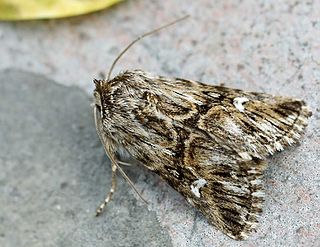
The silver-ground carpet is a moth of the family Geometridae. The species was first described by Michael Denis and Ignaz Schiffermüller in 1775. It is common throughout the Palearctic region including the Near East and North Africa.It is found in a variety of different habitats and occurs, for example, in humid forests, moorland and shore areas, on embankments or on unimproved grass meadows and heathlands as well as in gardens.

Mythimna impura, the smoky wainscot, is a moth of the family Noctuidae. The species was first described by Jacob Hübner in 1808. It is distributed throughout most of the Palearctic realm from Ireland in the west of Europe east to the Caucasus, Turkey, Syria, Kazakhstan, Russia, Siberia, Mongolia, then Japan. In Europe it is found from the Arctic Circle to Spain and Italy in the south, as well as in the northern regions of Greece.

Calophasia lunula is a Palearctic species of noctuid moth known by the common names toadflax moth and toadflax brocade moth.

Drymonia ruficornis, the lunar marbled brown, is a moth of the family Notodontidae. It is found in Central and Southern Europe and Anatolia.

Lygephila craccae, the scarce blackneck, is a moth of the family Erebidae. It is found in temperate Europe and across the Palearctic to the Altai Mountains, Korea, Japan and China.

Hadula melanopa, the broad-bordered white underwing, is a moth of the family Noctuidae. The species was first described by Carl Peter Thunberg in 1791. Subspecies H. m. melanopa is found in northern Scandinavia; subspecies H. m. rupestralis is found in the Alps, the Balkan Mountains and the Apennine Mountains; subspecies H. m. brunnea is found in mountainous areas of Great Britain and subspecies H. m. koizumidakeana is found in Japan.

Apamea furva, the confused, is a moth of the family Noctuidae. The species was first described by Michael Denis and Ignaz Schiffermüller in 1775. It is found throughout Europe. In southwestern Europe it is primarily montane. It is found as far north as the Arctic Circle. From Europe its range extends to Siberia, Turkey, Iran, Kyrgyzstan, Mongolia and Xinjiang in China.
Cassiana is a monotypic snout moth genus described by Carl Heinrich in 1956. Its only species, Cassiana malacella, was described by Harrison Gray Dyar Jr. in 1914. It is found in Mexico, the southern United States, the British Virgin Islands Puerto Rico and Bermuda.
Baphala goyensis is a species of snout moth in the genus Baphala. It was described by Émile Louis Ragonot in 1901, and is found in south-eastern Brazil, Uruguay and Argentina.
Vitula pinei is a species of snout moth in the genus Vitula. It was described by Carl Heinrich in 1956. It is found in the US states of California, Arizona, Texas and Utah.
Macrorrhinia dryadella is a species of snout moth in the genus Macrorrhinia. It was described by George Duryea Hulst in 1892 and is known from the US state of Florida.
Prorasea simalis is a moth in the family Crambidae. It was described by Augustus Radcliffe Grote in 1878. It is found in North America, where it has been recorded from Alberta, California, Colorado, Nevada and Oregon.
Microphysetica ambialis is a moth in the family Crambidae. It was described by William Schaus in 1924. It is found in Mexico (Xalapa) and Guatemala.
Agonopterix costimacula is a moth in the family Depressariidae. It was described by John Frederick Gates Clarke in 1941. The Global Lepidoptera Names Index lists it as a synonym of Agonopterix nigrinotella. It is found in North America, where it has been recorded from Maryland, Michigan, Ohio and Ontario.
Agonopterix oregonensis is a moth in the family Depressariidae. It was described by John Frederick Gates Clarke in 1941. It is found in North America, where it has been recorded from California to southern British Columbia.

Eucosma abstemia is a species of moth of the family Tortricidae first described by Edward Meyrick in 1932. It is found in the United States, where it has been recorded from Colorado, Arizona and California.
Machimia dolopis is a moth in the family Depressariidae. It was described by Walsingham in 1912. It is found in Mexico (Guerrero).
Ebbepterote is a monotypic moth genus in the family Eupterotidae. It was erected by Rolf G. Oberprieler, Wolfgang A. Nässig and Edward David Edwards in 2003. Its only species, Ebbepterote expansa, was described by Thomas Pennington Lucas in 1891. It is found in Australia, where it has been recorded from Queensland.
Aroga websteri is a moth of the family Gelechiidae. It is found in North America, where it has been recorded from Washington.
Cryptophasa phycidoides is a moth in the family Xyloryctidae. It was described by Thomas Pennington Lucas in 1901. It is found in Australia, where it has been recorded from New South Wales and Queensland.







